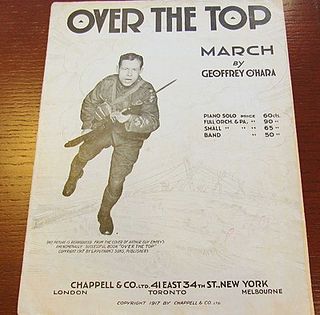
Over the Top: Military March is a World War I era song released in 1917. Geoffrey O'Hara composed the music. The song was published by Chappell & Co., Ltd. of New York, New York. On the cover, there is a picture of Arthur Guy Empey, charging with a rifle. In the background, there are soldiers and barbed wire. It is written for piano.
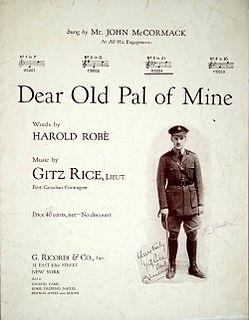
Dear Old Pal of Mine is a World War I song written by Harold Robe and Gitz Rice. The song was first published in 1916 by G. Ricordi & Co. in New York, NY.

When the Clouds of War Roll By is a World War I song composed by Earl Haubrich with lyrics by Nat Binns. It was published in 1917 by Ted Browne Music Co. in Chicago, Illinois.
We're Going Over the Top is a World War I song written by Andrew B. Sterling, Bernie Grossman, and Arthur Lange. It was published in 1917 by Joe Morris Music Co., in New York, NY. The sheet music cover, designed by Starmer, illustrates a battlefield scene with a tank moving over the top of a trench and soldiers inside the trench getting out of the way of the tank. Behind the tank soldiers march up the field.
Lafayette is a World War I song written and composed by Mary Earl, which was a pseudonymn of Robert A. King. It was published in New York, New York by Shapiro, Bernstein, & Co. in 1918. The sheet music cover, illustrated by Albert Barbelle, depicts soldiers marching with fixed bayonets below a statue of Lafayette in silhouette.
"Hock The Kaiser!" is a World War I song written and composed by James H. Hall in 1917. It targets the German emperor Wilhelm II of Germany. The work was self-published by James H. Hall in Chicago, Illinois.

"I'm Crazy Over Every Girl In France" is a World War I song written by Alfred Bryan and composed by Pete Wendling and Jack Wells. The song was published in 1917 by Waterson, Berlin, & Snyder Co., in New York, NY. The sheet music cover, illustrated by Barbelle, depicts a soldier standing against a sea wall with a woman on top of the wall, her arm on his shoulder watching another girl walking by and features battleships in the background.

"I'm Hitting The Trail to Normandy: So Kiss Me Goodbye" is a World War I song written and composed by Charles A. Snyder and Oscar Doctor. The song was published in 1917 by Snyder Music in New York, NY. The sheet music cover, illustrated by E.H. Pfeiffer, depicts a soldier kissing a woman good-bye with an inset photo of Paul Elwood.

"Giddy Giddap! Go On! Go On! We're On Our Way to War" is a World War I song written and composed by Jack Frost. This song was published in 1917 by Frank K. Root & Co., in Chicago, Illinois. The sheet music cover depicts a mule pulling four soldiers in a wagon.
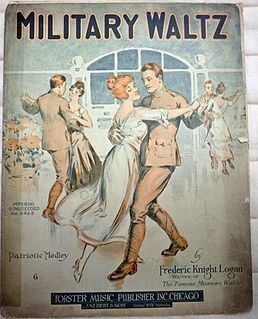
"Military Waltz" is a World War I song composed by Frederic Knight Logan. This song was published in 1917 by F.J.A. Forster, in Chicago Illinois. The sheet music cover features three soldiers dancing with women in a ballroom.

Send Me Away With A Smile is a World War I song written by Louis Weslyn and composed by Al Piantadosi. The song was first published in 1917 by Al. Piantadosi & Co., Inc. in New York, NY. The sheet music cover depicts a woman waving to a soldier from a fenced yard with an inset photo of Rita Gould.

Set Aside Your Tears is a World War I song written and composed by Wolfe Gilbert, Malvin Franklin, and Anatole Friedland. The song was first published in 1917 by Jos. W. Stern & Co. in New York, NY. The sheet music cover depicts a woman waving to marching troops.
We'll Carry The Star Spangled Banner Thru The Trenches is a World War I song written by Daisy May Pratt Erd. The song was first published in 1917 by Lang & Mendelsohn in Boston MA. The sheet music cover depicts soldiers advancing over barbed wire with a flag waving.
Let's All Be Americans Now is a World War I song written and composed by Irving Berlin, Edgar Leslie, and George W. Meyer. The song was first published in 1917 by Waterson, Berlin & Snyder Co., in New York, NY.The sheet music cover depicts a soldier with his rifle and silhouetted marching soldiers in the background. A popular recording in 1917 was made by the American Quartet.
Our Country's Voice Is Calling is a World War I march for voice and piano with drums and bugles ad libitum, written by O. Ebel and Luella Stewart with music by O. Ebel. The song was first published in 1917 by Chandler-Ebel Music Co., in Brooklyn, NY.
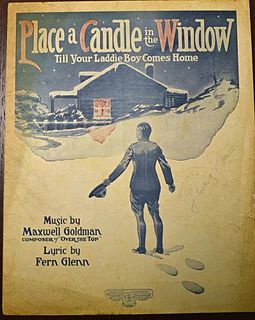
Place A Candle In the Window 'Till Your Laddie Boy Comes Home is a World War I song written by Fern Glenn and composed by Maxwell Goldman. The song was first published in 1918 by Buck & Lowney in New York, NY. The sheet music cover depicts a soldier returning to a snow covered house with a candle in the window.
We'll Knock The Heligo—Into Heligo—Out Of Heligoland! is a World War I song written by John J. O'Brian and composed by Theodore Morse. The song was first published in 1917 by Leo Feist Inc., in New York, NY. The sheet music cover depicts a terrified Kaiser standing on a cliff with a city below and United States soldiers rushing toward him.
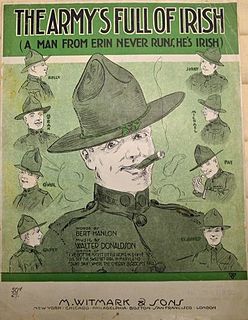
The Army's Full Of Irish is a World War I song written by Bert Hanlon and composed by Walter Donaldson. The song was first published in 1917 by Witmark & Sons in New York, NY. The sheet music cover depicts a soldier smoking a cigar flanked by eight soldiers with Irish names.
Where Do We Go From Here? is a World War I song written by Howard Johnson and composed by Percy Wenrich. The song was first published in 1917 by Leo Feist, Inc., in New York, NY. The sheet music cover features a photo of Collins and Harlin.
You Keep Sending 'Em Over and We'll Keep Knocking 'Em Down is a World War I song written by Sidney D. Mitchell and composed by Harry Ruby. The song was first published in 1917 by Waterson, Berlin & Snyder Co., in New York, NY. The sheet music cover depicts a soldier on top of a trench ladder uses his rifle as a club with an inset photo of Eddie Cantor.











